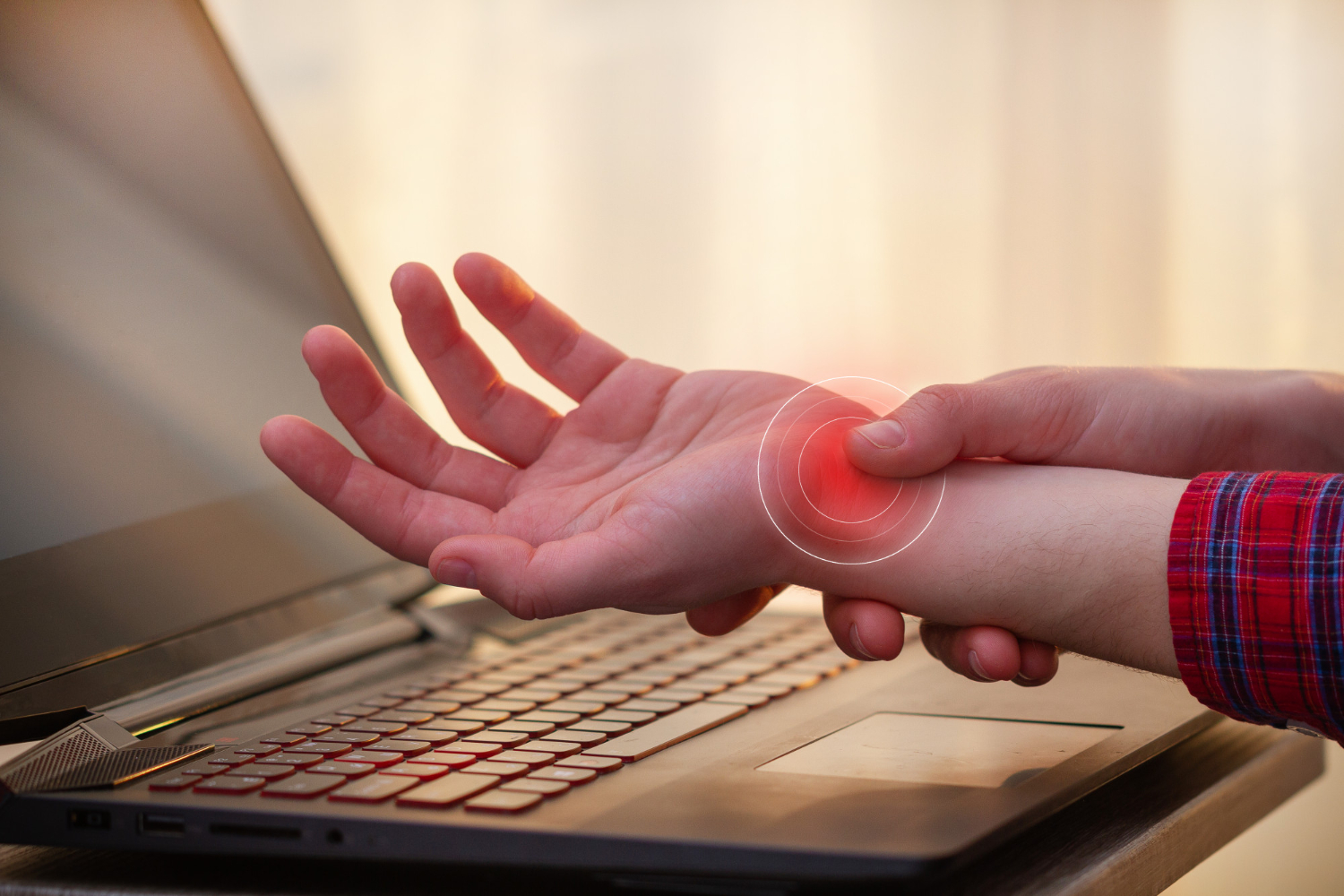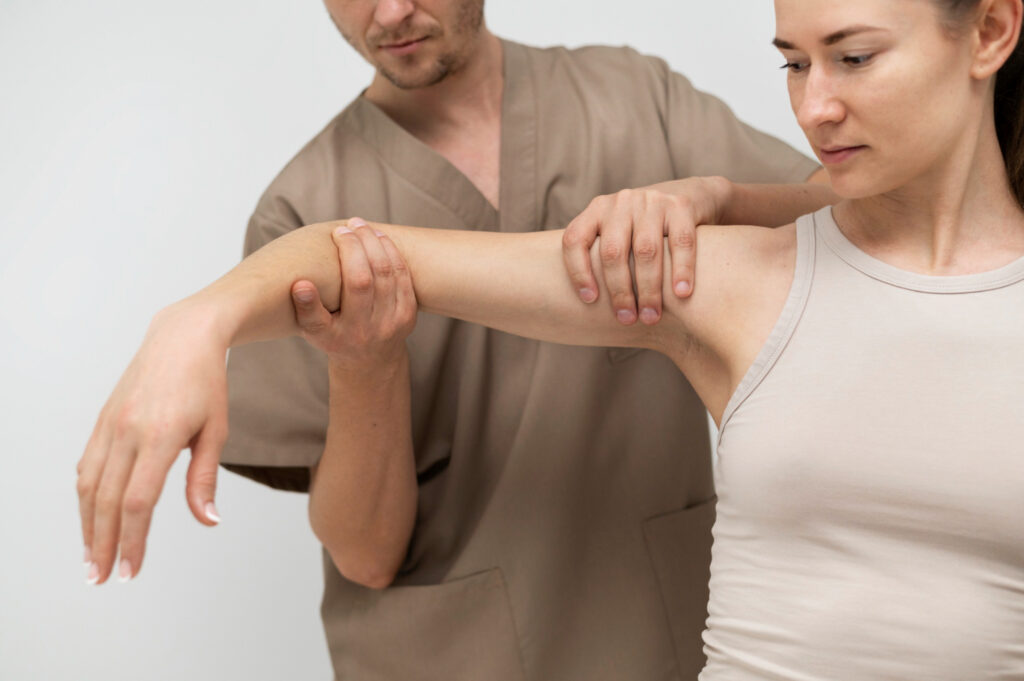If you’ve ever felt that sharp sting or lingering ache radiating through an arm or leg, you might be familiar with the discomfort of a pinched nerve. It’s like having a persistent, uninvited guest who overstays their welcome in the worst possible way.
This article will guide you through recognizing these pinched nerve healing signs so you can breathe easier, knowing recovery isn’t just possible; it’s underway. Dive into our insights for newfound comfort and promise!
What is a Pinched Nerve and How Does It Feel?
A pinched nerve happens when surrounding tissues, such as bones, cartilage, muscles, or tendons, apply too much pressure to a nerve. This pressure disrupts the nerve’s function, leading to pain, numbness, tingling sensations, or weakness along the path of the nerve.
Imagine a garden hose with water running through it; if someone steps on the hose, the water flow gets interrupted. Similarly, a pinched nerve can interrupt the ‘flow’ of neural signals from your spinal cord to areas in your body.
Signs of a Healing Pinched Nerve
Recognizing these pinched nerve healing signs is paramount in gauging your recovery progress. These indicators suggest that your body’s remarkable ability to mend compressed neural pathways is working effectively, ushering you into a phase where discomfort and limitations begin to subside.
1. Pinched Nerve Pain Starts to Dull
As your pinched nerve begins to heal, the sharp, searing pain often associated with this condition starts to fade. This dulling of pain signals that the pressure on the nerve is decreasing, and it’s starting to mend itself.
It can be a gradual process, but each day with less intense pain brings you closer to feeling like yourself again.
2. Decrease in Pain Radiating Outward
Feeling a decrease in pain that used to spread from the affected area is a clear sign your pinched nerve is healing. The sharp, shooting discomfort that once extended into your extremities becomes less intense and may not travel as far.
This reduction suggests that the pressure on the nerve has lessened, allowing it to start repairing itself.
3. Movements Don’t Cause a Flare-up
As your pinched nerve starts to heal, you’ll notice that everyday movements no longer trigger sharp jolts of pain. This is a sign that the nerve is recovering from its compressed state and can handle motion without causing discomfort or worsening symptoms.
You may find yourself able to twist, bend, or reach out for things with a newfound ease compared to when the pinched nerve was at its peak.
4. Fewer Instances of Pins and Needles
Imagine waking up without that familiar prickling sensation in your hand or foot – a sign your pinched nerve is on the mend. Pins and needles, also known as tingling sensations, are often associated with nerve compression, causing discomfort and numbness.
As you start noticing these episodes decrease in frequency and intensity, it’s a reassuring indicator that the healing process is underway. This improvement means the nerves are no longer irritated to the same degree, allowing them to recover their normal function.
5. Regaining Sensation in the Area
As the uncomfortable tingling subsides, you’ll notice another positive change: feeling starts to return to the once numb area. This might begin as a slight awareness of touch or temperature and gradually increase until full sensation is restored.
It’s a vital sign that your pinched nerve is healing, showing nerve signals successfully traveling through previously compressed pathways.
6. Improved Muscle Strength
If you’re recovering from a pinched nerve, noticing your muscles getting stronger is a great sign. This means the previously compressed nerve is healing and sending signals effectively to your muscles.
Stronger muscle contractions help stabilize joints, reducing the likelihood of further nerve compression. Remember that exercises and physical therapy for pinched nerves can be pivotal in regaining strength.
7. Increase in Joint Mobility
As your pinched nerve heals, you’ll likely notice an ease in joint movement. Joints that were once stiff and uncooperative due to the trapped nerve start to loosen up, allowing for smoother motion.
This increase in joint mobility is a clear sign of recovery. Inflammation is reduced and nerves are no longer as compressed. You might find yourself bending, reaching, or twisting with less pain and more fluidity.
8. Improved Range of Motion
Once your pinched nerve starts to heal, you’ll notice an improved range of motion. This means that those stiff joints and tight areas loosen up, allowing you to move more freely without discomfort.
Say goodbye to the days when turning your neck or bending over sent a jolt of pain through your body. Now, reaching for something on a high shelf or tying your shoes becomes easier and less painful.
9. Reduced Pressure on Compressed Nerve
Feeling less pressure on a compressed nerve is a strong sign that healing is underway. This relief can mean the inflamed tissues reduce size, taking stress off the nerve. As this symptom subsides, you’ll likely notice an improvement in comfort and function.
As the nerve gets more room to breathe, so to speak, it can begin to repair itself more efficiently.
10. Return Comfortably to Routines
As your pinched nerve heals, normal activities become less challenging. Daily routines once a source of discomfort, can now be approached confidently, and the fear of pain no longer holds you back.
This return to your usual self is a significant healing sign, indicating that the nerve compression has eased enough for you to move without thinking twice.
Factors That Can Help Speed Up the Healing Process

While experiencing the telltale signs of a pinched nerve easing up is reassuring, you might also be wondering how to expedite your path to full recovery. Certain measures can significantly influence the speed and effectiveness of your healing journey, ensuring that relief isn’t just on the horizon but arrives more swiftly.
At-Home Remedies
Managing a pinched nerve at home can significantly affect your healing process. Applying ice or heat to the affected area relieves swelling and temporary pain.
Gentle stretches and exercises can also help alleviate symptoms of pinched nerves, such as numbness and tingling. Tailor your activity level to what you can handle without pain—overexerting yourself could worsen symptoms.
Physical Therapy
While at-home remedies can relieve a pinched nerve, physical therapy often plays a vital role in rehabilitation. Through targeted exercises and hands-on treatments, therapists work to alleviate the immediate discomfort caused by nerve compression symptoms and strengthen affected areas to prevent future issues.
They customize routines that increase mobility and help you regain muscle strength without aggravating your condition. Techniques like stretching, strengthening exercises, and manual therapy are used to relieve pain and promote healing.
As you notice these healing signs, remember that patience is key. Your body is working hard to repair the nerve damage. Keep following your treatment plan and listen to your body’s needs during this time.
Chiropractic Treatment
Chiropractic treatment offers a hands-on approach to easing the discomfort of pinched nerves. Chiropractors manipulate your spine to reduce nerve compression, which can result in relief from pain and improved mobility.
Seeking chiropractic care could be a game-changer if you’re struggling with symptoms like numbness, weakness, or radiating pain. Regular sessions might alleviate current distress and enhance overall musculoskeletal health.
Stay positive as you reclaim strength and comfort day by day. With careful attention and self-care, you’ll be back to your usual activities before you know it.



